
The Lord of the Rings is an epic high fantasy novel by the English author and scholar J. R. R. Tolkien. Set in Middle-earth, the story began as a sequel to Tolkien's 1937 children's book The Hobbit, but eventually developed into a much larger work. Written in stages between 1937 and 1949, The Lord of the Rings is one of the best-selling books ever written, with over 150 million copies sold.
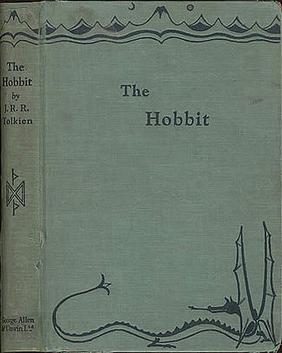
The Hobbit, or There and Back Again is a children's fantasy novel by the English author J. R. R. Tolkien. It was published in 1937 to wide critical acclaim, being nominated for the Carnegie Medal and awarded a prize from the New York Herald Tribune for best juvenile fiction. The book is recognized as a classic in children's literature and is one of the best-selling books of all time, with over 100 million copies sold.
Shelob is a fictional monster in the form of a giant spider from J. R. R. Tolkien's The Lord of the Rings. Her lair lies in Cirith Ungol leading into Mordor. The creature Gollum deliberately leads the Hobbit protagonist Frodo there in hopes of recovering the One Ring by letting Shelob attack Frodo. The plan is foiled when Samwise Gamgee temporarily blinds Shelob with the Phial of Galadriel, and then severely wounds her with Frodo's Elvish sword, Sting.
The Rings of Power are magical artefacts in J. R. R. Tolkien's legendarium, most prominently in his high fantasy novel The Lord of the Rings. The One Ring first appeared as a plot device, a magic ring in Tolkien's children's fantasy novel, The Hobbit; Tolkien later gave it a backstory and much greater power. He added nineteen other Great Rings, also conferring powers such as invisibility, that it could control, including the Three Rings of the Elves, Seven Rings for the Dwarves, and Nine for Men. He stated that there were in addition many lesser rings with minor powers. A key story element in The Lord of the Rings is the addictive power of the One Ring, made secretly by the Dark Lord Sauron; the Nine Rings enslave their bearers as the Nazgûl (Ringwraiths), Sauron's most deadly servants.
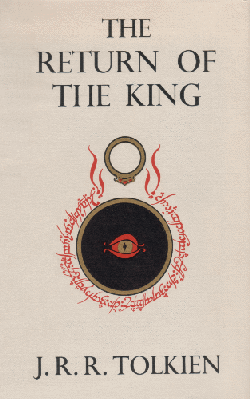
The Return of the King is the third and final volume of J. R. R. Tolkien's The Lord of the Rings, following The Fellowship of the Ring and The Two Towers. It was published in 1955. The story begins in the kingdom of Gondor, which is soon to be attacked by the Dark Lord Sauron.
The "Ainulindalë" is the creation account in J. R. R. Tolkien's legendarium, published posthumously as the first part of The Silmarillion in 1977. The "Ainulindalë" sets out a central part of the cosmology of Tolkien's legendarium, telling how the Ainur, a class of angelic beings, perform a great music prefiguring the creation of the material universe, Eä, including Middle-Earth. The creator Eru Ilúvatar introduces the theme of the sentient races of Elves and Men, not anticipated by the Ainur, and gives physical being to the prefigured universe. Some of the Ainur decide to enter the physical world to prepare for their arrival, becoming the Valar and Maiar.
The Big Read was a survey on books carried out by the BBC in the United Kingdom in 2003, where over three-quarters of a million votes were received from the British public to find the nation's best-loved novel. The year-long survey was the biggest single test of public reading taste to date, and culminated with several programmes hosted by celebrities, advocating their favourite books.

Jacqueline A. Carey is an American writer, primarily of fantasy fiction.

The Lord of the Rings: The Fellowship of the Ring is a 2002 action-adventure video game developed by WXP for the Xbox. It was ported to the Game Boy Advance by Pocket Studios and the PlayStation 2 and Microsoft Windows by Surreal Software. The game was published by Vivendi Universal Games under their Black Label Games publishing label. In North America, it was released for Xbox and Game Boy Advance in September, and for PlayStation 2 and Windows in October. In Europe, it was released for Xbox, Windows and Game Boy Advance in November, and for PlayStation 2 in December.
Scholars and critics have identified many themes of The Lord of the Rings, a major fantasy novel by J. R. R. Tolkien, including a reversed quest, the struggle of good and evil, death and immortality, fate and free will, the danger of power, and various aspects of Christianity such as the presence of three Christ figures, for prophet, priest, and king, as well as elements like hope and redemptive suffering. There is also a strong thread throughout the work of language, its sound, and its relationship to peoples and places, along with moralisation from descriptions of landscape. Out of these, Tolkien stated that the central theme is death and immortality.
The Sundering is a series of two fantasy novels by Jacqueline Carey made up of Banewreaker, and Godslayer. The books portray a conflict between light and dark, with many of the common conventions of fantasy fiction. The world and many of the characters of the novels are similar to those found in J. R. R. Tolkien's The Lord of the Rings, as Carey presents a similar story as a tragedy told from the "dark" side's perspective. Though one side can be considered light, consisting of Elf-like creatures, Men, and Dwarves, and the other dark, with an army of Trolls, neither can be considered solely "good" or "evil".
J. R. R. Tolkien's bestselling fantasy novel The Lord of the Rings had an initial mixed literary reception. Despite some enthusiastic early reviews from supporters such as W. H. Auden, Iris Murdoch, and C. S. Lewis, literary hostility to Tolkien quickly became acute and continued until the start of the 21st century. From 1982, Tolkien scholars such as Tom Shippey and Verlyn Flieger began to roll back the hostility, defending Tolkien, rebutting the critics' attacks and analysing what they saw as good qualities in Tolkien's writing.
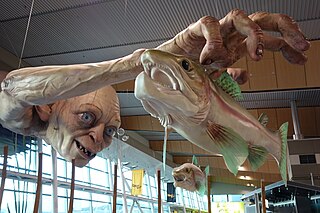
Gollum is a fictional character in J. R. R. Tolkien's Middle-earth legendarium. He was introduced in the 1937 fantasy novel The Hobbit, and became important in its sequel, The Lord of the Rings. Gollum was a Stoor Hobbit of the River-folk who lived near the Gladden Fields. In The Lord of the Rings it is stated that he was originally known as Sméagol, corrupted by the One Ring, and later named Gollum after his habit of making "a horrible swallowing noise in his throat".

Saruman, also called Saruman the White, later Saruman of Many Colours, is a fictional character in J. R. R. Tolkien's fantasy novel The Lord of the Rings. He is leader of the Istari, wizards sent to Middle-earth in human form by the godlike Valar to challenge Sauron, the main antagonist of the novel, but eventually he desires Sauron's power for himself and tries to take over Middle-earth by force from his base at Isengard. His schemes feature prominently in the second volume, The Two Towers; he appears briefly at the end of the third volume, The Return of the King. His earlier history is summarised in the posthumously published The Silmarillion and Unfinished Tales.
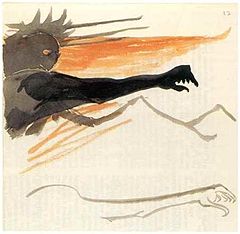
Sauron is the title character and the primary antagonist, through the forging of the One Ring, of J. R. R. Tolkien's The Lord of the Rings, where he rules the land of Mordor and has the ambition of ruling the whole of Middle-earth. In the same work, he is identified as the "Necromancer" of Tolkien's earlier novel The Hobbit. The Silmarillion describes him as the chief lieutenant of the first Dark Lord, Morgoth. Tolkien noted that the Ainur, the "angelic" powers of his constructed myth, "were capable of many degrees of error and failing", but by far the worst was "the absolute Satanic rebellion and evil of Morgoth and his satellite Sauron". Sauron appears most often as "the Eye", as if disembodied.

The Fellowship of the Ring is the first of three volumes of the epic novel The Lord of the Rings by the English author J. R. R. Tolkien. It is followed by The Two Towers and The Return of the King. The action takes place in the fictional universe of Middle-earth. The book was first published on 29 July 1954 in the United Kingdom. The volume consists of a foreword, in which the author discusses his writing of The Lord of the Rings, a prologue titled "Concerning Hobbits, and other matters", and the main narrative in Book I and Book II.
Christianity is a central theme in J. R. R. Tolkien's fictional works about Middle-earth, but the specifics are always kept hidden. This allows for the books' meaning to be personally interpreted by the reader, instead of the author detailing a strict, set meaning.
Commentators have compared Peter Jackson's 2001–2003 The Lord of the Rings film trilogy with the book on which it was based, J. R. R. Tolkien's 1954–1955 The Lord of the Rings, remarking that while both have been extremely successful commercially, the film version does not necessarily capture the intended meaning of the book. They have admired Jackson's ability to film the long and complex work at all; the beauty of the cinematography, sets, and costumes; the quality of the music; and the epic scale of his version of Tolkien's story. They have, however, found the characters and the story greatly weakened by Jackson's emphasis on action and violence at the expense of psychological depth; the loss of Tolkien's emphasis on free will and individual responsibility; the flattening out of Tolkien's balanced treatment of evil to a simple equation of the One Ring with evil; and the replacement of Frodo's inner journey by an American monomyth with Aragorn as the hero.
Tolkien's monsters are the evil beings, such as Orcs, Trolls, and giant spiders, who oppose and sometimes fight the protagonists in J. R. R. Tolkien's Middle-earth legendarium. Tolkien was an expert on Old English, especially Beowulf, and several of his monsters share aspects of the Beowulf monsters; his Trolls have been likened to Grendel, the Orcs' name harks back to the poem's orcneas, and the dragon Smaug has multiple attributes of the Beowulf dragon. The European medieval tradition of monsters makes them either humanoid but distorted, or like wild beasts, but very large and malevolent; Tolkien follows both traditions, with monsters like Orcs of the first kind and Wargs of the second. Some scholars add Tolkien's immensely powerful Dark Lords Morgoth and Sauron to the list, as monstrous enemies in spirit as well as in body. Scholars have noted that the monsters' evil nature reflects Tolkien's Roman Catholicism, a religion which has a clear conception of good and evil.
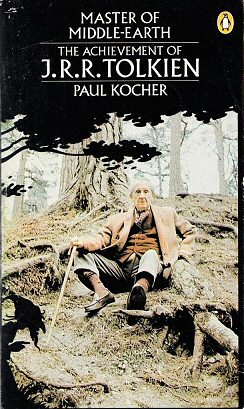
Master of Middle-earth: The Fiction of J. R. R. Tolkien, alternatively subtitled The Achievement of J.R.R. Tolkien, is a 1972 book of literary criticism of J. R. R. Tolkien's Middle-earth fantasy writings, written by Paul H. Kocher, and one of the few to be published in Tolkien's lifetime. It focuses especially on The Lord of the Rings and The Hobbit, and also covers some of his minor works such as "Leaf by Niggle" and "Smith of Wootton Major".










